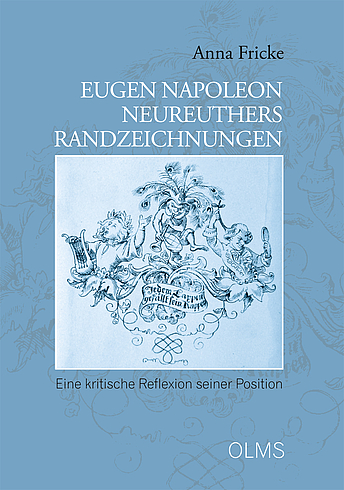Fricke
Eugen Napoleon Neureuthers Randzeichnungen
ISBN 978-3-487-15825-9
englischAs a young man the Munich artist Eugen Napoleon Neureuther (1806-1882) fell out of favour with King Ludwig I when he was commissioned by the publisher Cotta to illustrate the 1830 Parisian July Revolution in a series of large-format arabesques. The renewed wave of revolutionary movements in many European countries around 1830 caused a reactionary turn in Bavaria too. Afterwards Neureuther avoided overtly political expressions in his art, making his name instead with literary marginal illustrations and arabesques, and becoming known in contemporary biographies as a late-romantic conservative arabesque artist. However, a careful reading of his arabesque marginalia show that these do not merely illustrate the literary texts they accompany, but interpret and comment on them, and in some cases even critically undermine them. Neureuther’s lasting sympathies with liberalism can also be clearly perceived. Anna Fricke’s monograph publishes and discusses for the first time all the preliminary sketches for Neureuther’s marginal illustrations for German literary classics, which the artist conceived in direct connection with his revolutionary arabesques, as well as other drawings. In addition, the artist’s manuscript archive, which is in private hands and has only been selectively cited in the literature on Neureuther, is fully listed. Altogether this study corrects the previous one-sided biographical view of the artist.
Der Münchner Künstler Eugen Napoleon Neureuther (1806-1882) fiel als junger Mann bei König Ludwig I. in Ungnade, als er im Auftrag des Cotta-Verlags die Pariser Julirevolution von 1830 in großformatigen Arabesken illustrierte. Die in verschiedenen europäischen Ländern erneut aufkommenden revolutionären Bewegungen um 1830 bewirkten auch in München eine reaktionäre Wende. Neureuther mied in Folge klare politische Äußerungen in seiner Kunst, profilierte sich weiter mit literarischen Randzeichnungen und ging in die zeitgenössischen Biografien als spätromantisch-konservativer Arabeskenzeichner ein. Eine aufmerksame Lektüre seiner arabesken Randzeichnungen zeigt jedoch, dass diese die literarischen Texte nicht nur illustrieren, sondern interpretieren, kommentieren und in einigen Fällen sogar kritisch untergraben. Auch Neureuthers fortdauernde Sympathien für den Liberalismus treten dabei deutlich zutage. In der Monographie von Anna Fricke werden die vollständigen Vorzeichnungen zu Neureuthers Randzeichnungen um Dichtungen der deutschen Classiker, die der Künstler direkt im Anschluss an seine Revolutionsarabesken konzipierte, sowie weitere Handzeichnungen zum ersten Mal veröffentlicht und besprochen. Zudem wird der handschriftliche Nachlass des Künstlers in Privatbesitz, der in der Neureuther-Literatur bisher nur punktuell zitiert wurde, in einem Regest aufgearbeitet. Insgesamt korrigiert die vorliegende Studie die bisherige einseitige biographische Sicht auf den Künstler.


